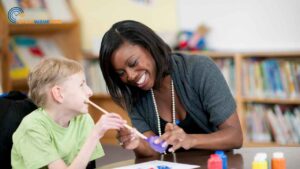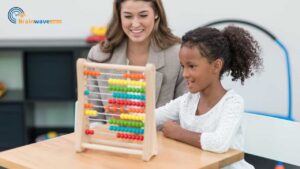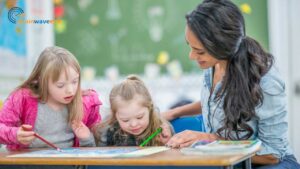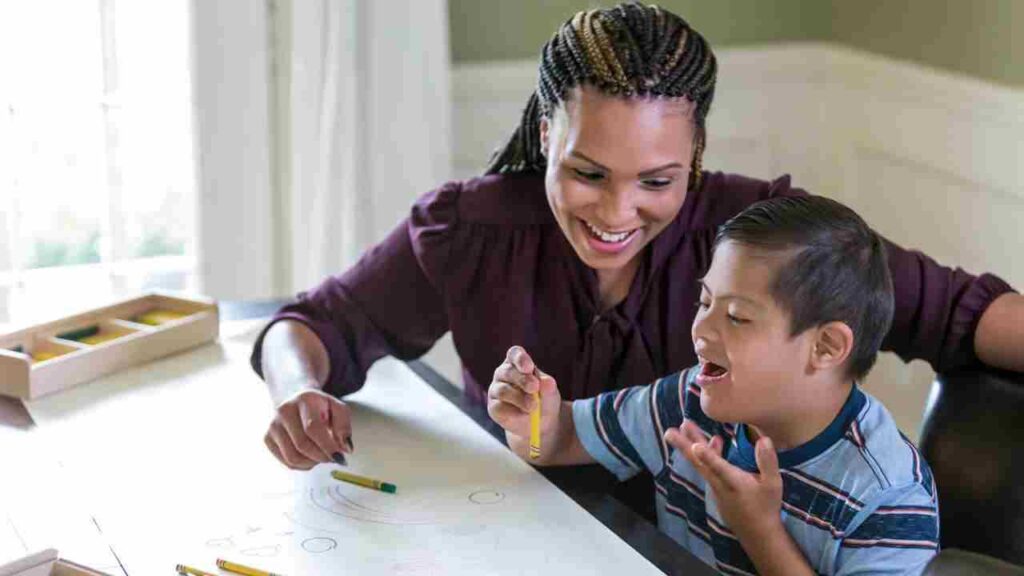Creating an inclusive and safe environment in a special education classroom is essential for the successful learning of its students. It is important for educators to understand the purpose of special education programs, analyze classroom structures, build connections with families and ensure that necessary resources are available.
With the right strategies, special education teachers can encourage positive behavior and create a welcoming learning environment for all students. In this article, we will discuss how to create a safe and inclusive environment in a special education classroom.
Definitions
When it comes to special education classrooms, the overall environment should be one of safety, security, and inclusion. This means that both the physical and the emotional environment must be welcome and conducive to learning and growth. To achieve this, educators must be aware of the various definitions, tools, and strategies that make up a safe and inclusive environment.
The most basic definition of a special education classroom is one that is designed to meet the individual needs of students with special needs or exceptional abilities. This can include such factors as providing accommodations for physical limitations, creating a more personal learning environment, and ensuring individualized attention is given to each student. In order to meet the needs of each student, the educator must be aware of the various definitions related to special education.
One of the most important definitions related to special education is that of Individual Education Plans (IEPs). IEPs are written documents outlining a student’s individual education objectives and goals. These documents spell out the instruction, accommodations, and services needed to meet the student’s individual goals as well as the progress that is expected to be made. It is important for educators to be familiar with IEPs as they are a vital part of creating a safe and inclusive environment.
Another important definition to consider when thinking of special education classrooms is that of Universal Design. Universal Design is an approach to creating environments that are accessible to users of all abilities and disabilities. This includes aspects such as a focus on physical access, functional design, and social inclusion. Universal Design is essential in creating a classroom environment where all students are included and feel welcome.
When it comes to creating a safe and inclusive environment in the special education classroom, educators also need to consider behavioral expectations and interventions. Establishing and maintaining clear expectations for behavior is crucial in creating an environment where all students feel safe and supported.
This can involve making sure that students understand the rules in the classroom, providing clear information on any behavioral expectations, and having a system of consequences in place for when students do not follow the rules. Additionally, interventions such as positive reinforcement and social skills training can be used to encourage positive behavior and create a safe and inclusive atmosphere.
Purpose of Special Education Programs

These programs help children and adolescents with learning, behavior, cognitive, physical, and emotional challenges to progress within the school system and reach their full potential.
Special education programs employ a variety of strategies to create an inclusive atmosphere for students. These strategies can include a modified curriculum, personalized instruction, and collaboration with outside resources such as therapists and professionals.
Special education professionals also make sure that any accommodations that students need, such as additional time to complete assignments or alternative testing methods, are available. In some cases, schools provide assistive technology, such as speech-to-text software and adaptive keyboards, to help facilitate a student’s learning.
Special education programs create an encouraging and supportive environment for learning by building relationships with students. This helps students to build trust in their educators and to learn new skills that will benefit them in their future education and career goals. Educators work hard to create an atmosphere of mutual respect and open communication, which helps to foster a sense of community and acceptance among students.
Special education programs are also focused on teaching students to advocate for themselves and develop a wide variety of skills. They provide students with the tools they need to be successful in the classroom and in life. Special education programs promote self-advocacy, collaboration, communication, problem-solving, and executive functioning skills.
Ultimately, the goal of special education programs is to ensure that every student receives quality instruction and support in order to help them reach their goals. By creating a safe and inclusive environment, special education programs provide quality instruction and support to students of all abilities.
Read also: Implementing Special Needs Education: Essential Strategies
Creating Inclusive Environments

This is especially important in special education classrooms, as this is where students with disabilities, learning difficulties, and special requirements can thrive and reach their potential.
In order to create an inclusive environment, teachers must be aware of each student’s needs and create learning experiences that are tailored to the individual. Teachers should strive to respect the diversity of all their students, and it is important to be open and welcoming to all.
Classroom rules must be established, and all students should be expected to abide by them. This includes expectations concerning behavior, respect for one another, and responsibilities. Teachers should use positive reinforcement as a tool to encourage good behavior, and focus on what students are doing right rather than pointing out mistakes. In addition, they should be aware of any potential triggers that could cause a student to become frustrated of anxious, and take steps to address them.
In order to foster an inclusive environment, teachers should use multiple teaching strategies and techniques that appeal to different learning styles. Differentiated instruction, for example, allows teachers to modify and adjust lessons to a student’s individual needs. Additionally, small group instruction and cooperative learning can provide students the opportunity to get to know one another, work together to solve problems and understand different perspectives.
Finally, it is important to not only recognize and celebrate individual differences but also to celebrate the accomplishments of all students. Everyone should be given the opportunity to contribute and be part of the conversation. Celebrating successes, no matter how small, is a great way to build self-esteem and create an environment where everyone feels included and appreciated.
Analyzing Classroom Structures
When it comes to creating a safe and inclusive environment for special education students in the classroom, the structure of the classroom itself is an important factor. Creating an environment that is conducive to learning requires careful consideration of the physical layout of the classroom and the resources allocated to the students. Here, we will explore how to analyze classroom structures to maximize the effectiveness of the learning environment.
First, when analyzing classroom structures in special education classrooms, the use of space is an important factor. It is important to create a layout that is comfortable and conducive to learning. Classroom layouts should be designed to allow students to move around freely and interact with one another and their teacher. This can include activities such as circle time, large floor activities, and other physical activities. Additionally, it is important to provide enough space for students with special needs to feel comfortable.
Second, when planning the classroom structure, it is important to consider the available materials and resources for students. In special education classrooms, the classroom environment should be set up to meet the individual needs of the students. This means providing a variety of materials tailored to their specific interests and learning styles. For example, tactile materials can be provided to help engage students with different learning styles. Technology is also a useful resource in special education classrooms, and having access to tablets, computers, and other digital tools can help make learning more accessible.
Finally, it is important to consider the classroom environment. This includes the physical environment such as temperature, noise levels, and lighting, as well as the social environment in the classroom. Special education classrooms should be welcoming, inclusive, and supportive of all students. This means creating an atmosphere where students feel accepted and respected and can be themselves without fear of judgment or stigma.
Adequate planning and analysis of classroom structures can help ensure that special education students have access to a safe and inclusive learning environment. By considering the use of the space, resources, and classroom environment, educators can create an effective learning atmosphere for special education students.
Read also: Education Considerations for Students with Autism
Building Connections with Families
Creating an environment of inclusion and safety in a special education classroom begins with building strong connections with the families of our students. Establishing meaningful connections with the parents and families of our students is essential to ensure that everybody is on the same page and that each student is able to thrive in their learning environment.
It is important to make every effort to build rapport with the family members of our students. This involves regularly engaging with parents in order to create a sense of community and trust. Setting up regular check-ins with parents is a great way to keep them up to date on their child’s progress, as well as gain insight into how to best support their child’s learning. This could include having parent-teacher conferences, online surveys, or even implementing home visits to get a better understanding of their family context.
Another way to create lasting connections with our families is by being proactive and inviting them to be involved in the classroom. Inviting parents to come in and participate in classroom activities or celebrations can help to foster strong relationships and create an atmosphere of collaboration. Additionally, inviting families to school-wide events or activities can allow them to connect with other families and create stronger bonds with the school community.
Building strong relationships with families is essential to creating an inclusive and safe environment for all students in a special education classroom. By engaging with families and taking the time to understand their needs and concerns, we can create a shared understanding and be better equipped to provide the best support for our students.
Supporting Inclusivity and Respect

• Listen to all students and their perspectives, regardless of their backgrounds, disabilities, and other factors.
• Create structure and clear expectations within the classroom, including consequences for negative behavior and rewards for positive behavior.
• Incorporate activities and discussion topics that speak to the diversity of the student population.
• Ensure all students are able to participate in classroom activities. This might include providing alternative options for students who need special accommodations.
• Develop relationships with students that are grounded in respect, trust, and understanding.
• Model respect and inclusivity for students by speaking and behaving in a manner that is respectful and inclusive.
• Actively encourage students to respect one another, regardless of their backgrounds and beliefs.
• Be open to hearing the individual perspectives of students and responding in a respectful and constructive manner.
By taking these steps, teachers can help create an environment of inclusivity and respect in the special education classroom. In doing so, teachers help make the classroom an inviting and safe space for every student and foster a sense of belonging and unity in the classroom.
Ensuring Special Education Resources are Available
Ensuring special education resources are available to all students is an essential part of creating a safe and inclusive learning environment in the classroom. All students require access to the same educational resources in order to reach their academic potential. However, students with disabilities often face extra challenges when it comes to accessing the same materials, services, and support that their peers have. Providing access to special education resources is the key to success in the classroom.
The first step in making sure that students have the resources they need is to ensure that those resources are available in the first place. This means that teachers, administrators, and school staff need to be aware of what accommodations and resources are available for specific students. Having a comprehensive list of available resources and services available for special education students will be the foundation for providing the necessary support for them.
In addition to that, there must be a clear structure in place for obtaining and distributing these resources. This includes ensuring that students and parents know how to access these resources and what steps they need to take to get them. It also means that educators need to be aware of the resources and services that are available, and have a system in place to connect parents and students with the proper resources they need.
At the same time, it is important that students have access to necessary resources in a timely manner. This means that the process for obtaining these resources should be quick and straightforward. Special education resources should be organized and available at the start of each school year, along with the resources that all students need. Creating a system for quickly obtaining resources is essential for making sure that each student in the classroom has access to what they need.
Finally, providing access to special education resources also requires creating an environment where students feel supported and comfortable. This means that school staff needs to create an atmosphere of openness and understanding when providing these resources. Educators should strive to create a safe and inclusive learning environment for all students, and make sure that the resources are available to everyone, regardless of abilities and differences.
By taking these steps, schools can ensure that special education resources are available and accessible to all students, allowing them to reach their full potential in the classroom.
Read also: Supportive Home Environment For A Down Syndrome Child
Developing Appropriate Behaviour Expectations

To begin, teachers should consult with individual students to better understand their behavior expectations and to ensure they are developmentally appropriate. This can be done through conversations with the student, observations of behavior, and/or student assessments. Through these conversations and assessments, the teacher can develop an understanding of the student’s behavior expectations and any issues that should be considered when developing expectations.
The teacher should also work with other adults in the classroom to identify any behavior expectations that are specific to that environment. This could include expectations related to academics, such as completing assignments in a timely manner, or expectations related to social interaction, such as respecting the opinions of others. It is important for these expectations to be clearly outlined so that all students in the classroom understand them.
The teacher should also consider the needs of the entire classroom when developing behavior expectations. This could include expectations related to respect for others and for the classroom environment. These expectations should be framed in a positive way and should be based on the individual characteristics and needs of each student.
Ultimately, developing appropriate behavior expectations for students in a special education classroom is essential for creating a safe and inclusive environment. By considering the individual needs and characteristics of each student, as well as the needs of the classroom as a whole, teachers can ensure that they are creating expectations that are developmentally appropriate and that will foster a positive learning environment.
Read also: What Are the Main Difficulties of Students With Autism?
Encouraging Positive Behaviour
Creating a safe and inclusive environment in the special education classroom begins with encouraging positive behaviors from all students. It is important that educators take the time to provide each student with positive reinforcement for their successes, as well as to address any negative behaviors that may arise. Positive reinforcement should be given for both individual successes as well as for behaviors that create a more understanding and supportive learning environment.
One method educators can use to encourage positive behavior is to provide verbal praise for each student’s success. Setting short-term goals and providing students with encouragement and praise when they reach it can help to boost self-confidence and create a more supportive learning environment. Educators should also ensure that all students receive recognition for their efforts and that those who are excelling in the classroom are referred to as role models for the other students.
In addition to verbal praise, it is important that educators implement rewards and consequences for student behavior. If a student is exhibiting positive behavior, they should be rewarded with something tangible such as a special treat or extra free time. When students behave in a negative manner, they should be reminded and encouraged to behave appropriately and given consequences that fit the infraction.
Finally, educators should strive to create an environment where all students feel accepted, respected, and safe. This can be achieved by providing a space for students to express themselves, teaching respect and understanding, and fostering an environment of inclusion. By taking the time to address each student’s unique needs and providing a safe and supportive environment, educators can ensure that their special education classroom is one in which students can thrive.
Read also: Why We Need Both Autism Awareness And Acceptance
Implementing Consequences for Unacceptable Behaviour
When students in a special education classroom display unacceptable behavior, there need to be clear consequences for those actions. It is essential to have a system in place to impart those consequences in order to create a safe and inclusive learning environment.
When implementing consequences, it is important to ensure that they are appropriate and proportional to the behaviors displayed. For example, consequences should be more serious when inappropriate behaviors are more serious. This helps to ensure that students understand the purpose of setting and enforcing rules.
Some examples of consequences could include verbal warnings, timeouts, or loss of privileges. It is important that the severity of the consequence matches the severity of the unacceptable behavior. For example, if a student is behaving aggressively, a timeout would be more appropriate than simply a verbal reprimand.
Fostering a sense of mutual respect is key in any classroom, and this includes a special education classroom. The consequences should be applied fairly and consistently for all students so that all students understand what is expected of them.
When implementing consequences for unacceptable behavior, it is important to look at the causes of the behavior. Consider what the student might have been feeling or thinking before the behavior happened, and then brainstorm strategies with the student and other professionals involved in the student’s learning environment to help the student manage their emotions better in the future.
Creating a safe and inclusive learning environment for students in special education classrooms requires the implementation of clear and appropriate consequences for unacceptable behaviors. This helps to ensure that students understand the purpose of setting and enforcing rules, foster a sense of respect, and work to identify the root causes of the behaviors being displayed.
Conclusion
Creating a safe and inclusive environment in the special education classroom is essential to helping students develop both academically and socially. This includes the physical environment, staff interactions, instructional style and materials, and the curriculum. When the environment is conducive to learning, it can help to create a positive atmosphere where students can feel comfortable and secure. By paying attention to how the environment is structured, it is possible to create an atmosphere in which diversity and inclusion are celebrated, and all students are respected. With these changes, students will have a better chance of success as they navigate their special education journey.







